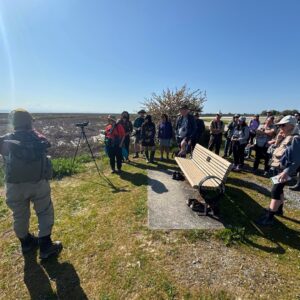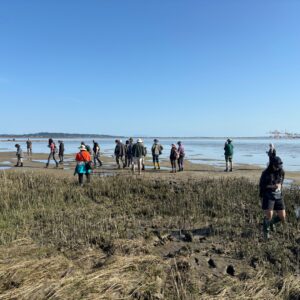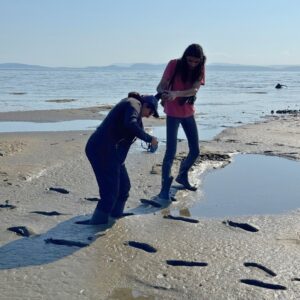Celebrating World Migratory Bird Day!
When we hear the word ‘migration’, we often think of The Great Migration in the Serengeti — a spectacle with millions of wildebeest and zebras migrating in search of water and opportunities to graze. Many of us have this in our ‘bucket list’ – I, for one, definitely do! Every time I draw an imaginary line on the limit of how incredible nature is, I am forced to erase and extend it. It now seems boundless.
On World Migratory Bird Day, let’s talk about yet another migration feat, and shine the spotlight on bird migrations and their journeys that epitomize resilience, grit and precision. Guided by the Earth’s magnetic field and other celestial cues, these birds traverse oceans, continents, and brave extreme weather events to reach their final destinations.
This year’s Migratory Bird Day theme is ‘Shared Spaces: Creating Bird-Friendly Cities and Communities’, and this feels like the perfect opportunity to bring up our feathered friends, the Western Sandpipers (WSPs), and the space we share: Roberts Bank.
Western Sandpipers & Roberts Bank
Every year, like clockwork, WSPs congregate at Robert’s Bank around springtime as they travel through the Pacific Flyway — one of the four main migratory flyways of North America. This region is critical for WSP as it serves as the last stopover site before they commence the last leg of their journey to Alaska which entails flying over a 1000 miles without a break! This is in addition to starting their journey from all the way south in Chile! The congregation is a spectacle to behold as one could easily mistake it for a low shimmering cloud mimicking a mirage, with over a 100,000 flying in unison making up this wondrous ‘cloud’.

What’s so special about Roberts Bank?
Roberts Bank is a unique ecological feeding ground along the Pacific Flyway and one of the most biologically productive ecosystems in the world. These birds stop over at Roberts Bank looking for their favourite food – ‘biofilm’. The slimy, unassuming mudflats in this area are covered with algae, bacteria, and organic matter that are a lifeline to these birds, contributing up to 60% of their diet. Think of the biofilm as an energy packed smoothie that helps you run a marathon. The consequences of losing these mudflats will be reflected beyond our tiny friends, as it forms the base of the food chain of the Salish Sea, ultimately supporting salmon and all the way up to the Southern Residents, directly or indirectly.
Biofilm and Orcas?
Apart from playing a critical role in facilitating a successful migration of the Western Sandpipers, biofilm has a crucial role to play in linking the Salish Sea ecosystem, and supporting a myriad of species that depend on it. It is hard to make that connection, but once you see it, it is hard to unsee.
Let’s look at the Salish Sea through the lens of biofilm!
Consisting of algae, bacteria, and organic matter, biofilm serves as food for invertebrates and plays a crucial role in nutrient cycling by making nitrogen and phosphorus that help the growth of other phytoplankton and seagrass. Juvenile fish like herring then feed on these invertebrates and also use biofilm as a habitat for protection as they grow. Once they grow, these smaller fish serve as prey to larger fish like salmon, which also use seagrass for protection as they grow, and a myriad of birds. Thus, an imbalance in this biofilm-based ecosystem would ultimately cause disruption in energy transfer across key cascade levels. A drop in smaller fish like herring would cause changes in salmon populations which are the main prey for Southern Resident killer whales. The nitrifying bacteria also present in the biofilm help in the maintenance of water quality and nutrient cycling in the waters. In many ways, protecting biofilm is protecting the overall health of the Salish Sea!

Roberts Bank in peril
The recently approved Roberts Bank Terminal 2 megaproject will have far-reaching impacts on the entire Fraser River ecosystem by destroying critically important habitat for millions of marine critters and humans alike around the Salish Sea. This $3.5 billion project will add an additional 2.4 million 20-foot shipping containers and required infrastructure to the waters of the Salish Sea. The devastation this will cause is truly frightening for humans and non-humans alike—potential oil spills, underwater noise, contaminant pollution, chronic health risks, disrupted migration patterns, economic uncertainty for fisheries and other industries; the list goes on.
The project, equivalent to 330 football fields in size, overlaps with critical habitat for the Southern Resident killer whales and millions of birds that use this as a stopover site along the Pacific Flyway — including our tiny friends, the Western Sandpipers.
GSA has been involved in advocating against RBT2 over the many years. To learn more click here.
We are concerned that these impacts do not just remain within the waters, but drastically affect local economies that depend on the estuary. More polluted waters; lesser abundance for sustainable fishing; increased vulnerabilities to chronic auditory, respiratory, and water-borne health risks; threats to Indigenous food sovereignty and food security; and ultimately an imbalance in a system that is less resilient towards natural disaster, and more vulnerable to the consequences of climate change.
Protecting this habitat means protecting these incredible birds and so much more. It is about taking care of the entire Salish Sea ecosystem by ensuring that all human and non-human communities living in and around the region do not face disproportionate impacts from the project’s construction and future use.
Plus, if the birds are taking on this mammoth of a journey, the least we could do is be good hosts!

What can you do?
For the project to be constructed, it requires permits under the Fisheries Act and the Species at Risk Act (SARA). This permitting process is on a longer timeline, and that’s our opportunity.
Following the environmental assessment, Roberts Bank Terminal 2 megaproject was approved with a staggering 370 conditions in place to ameliorate the threats it poses to the entire ecosystem — clearly identified and acknowledged in the assessments. Situated between the feeding grounds and the shore, this colossal project is bound to have detrimental impacts on this critical habitat. We must have our eyes on condition 10.4, which requires clear evidence that these mudflats are not destroyed beyond a certain threshold. Imagine you have practiced for this marathon for months, and suddenly at your final check-point your last energy drink vanishes, and there’s 1000 kilometers to go.
This could cause fatal consequences to this population, making their migration less of a marathon but a game of chance, not knowing whether these birds can even make it to their final destination. This issue becomes even more pertinent knowing that this is almost the entire world’s WSP population and Roberts Bank is one of the last remaining functional mudflats in the Fraser Estuary.
The newly elected Liberal Government has made some promises and commitments on biodiversity protection and nature conservation. Our decade long fight against RBT2 is not over, and we will continue to advocate for what is right and hold the government accountable to ensure compliance to regulations and safeguards. The Salish Sea and the Fraser Estuary need stronger protection and care as they’re some of the most productive ecosystems in the world, right in our backyards.
Join us in the community!
GSA is excited to be out in the community! Recently, along with Wonders of the Salish Sea and Special Bird Service, we conducted a guided tour at Brunswick Point/šxʷɬiəm in Delta. This guided walk with the community gave us the opportunity to witness thousands of WSPs together, look closely and understand the criticality of biofilm in this habitat, and it was a delight to meet so many of you wonderful community members.
We were also joined by Isabelle Groc, director, writer, and producer of the Sandpiper’s Last Supper and Bob Elner, a renowned ornithologist who reshaped migration science and discovered biofilm feeding in WSPs! Check out Isabelle’s newest film here.
Stay tuned by signing up for our newsletter and following us on social media for more exciting events!
Videos & photographs: Isabelle Groc. Image gallery: Khalid Boudreau & Kayla Isomura.



